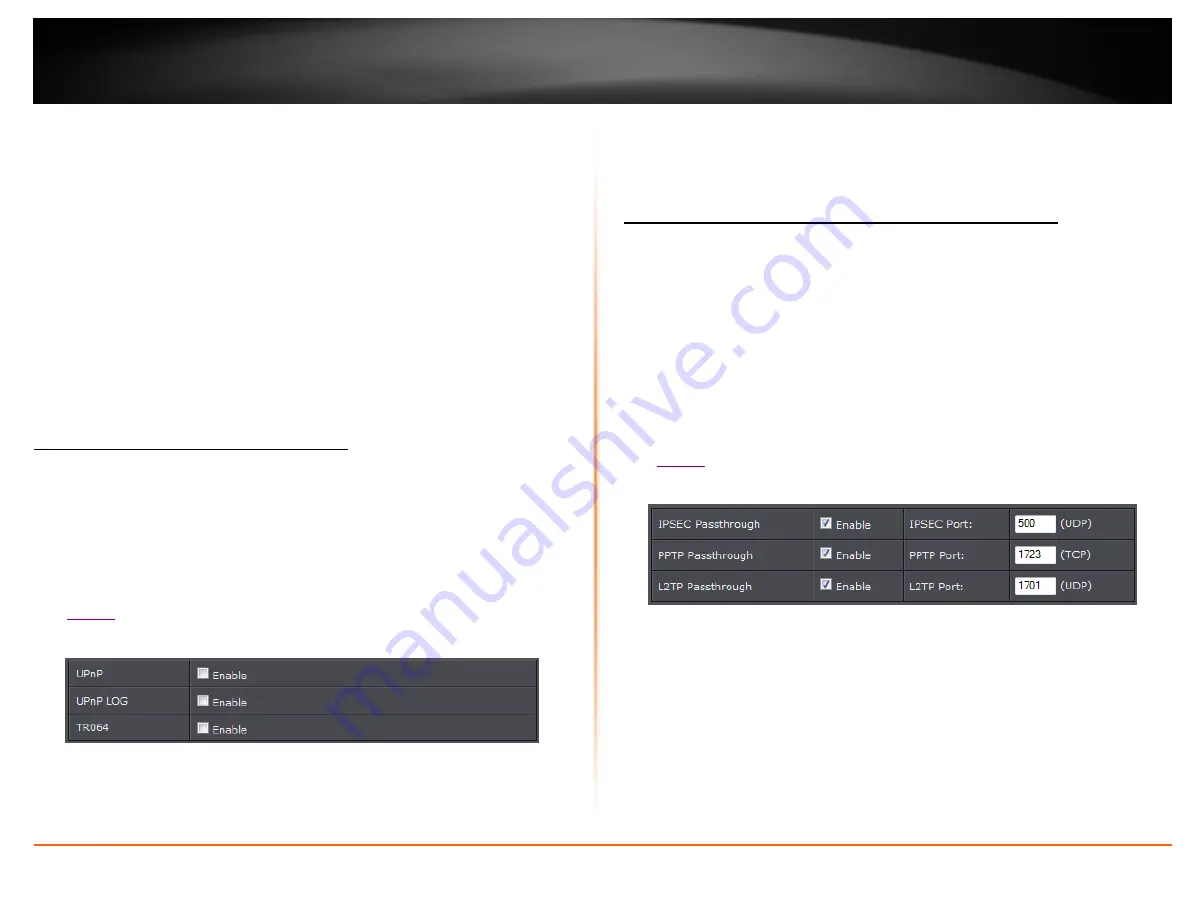
© Copyright 2014 TRENDnet. All Rights Reserved.
TRENDnet User’s Guide
TEW-721BRM
30
Sub Range IP Enable:
Check this box to set another range of IP address.
Vendor Class (Option 60): Enter a vendor class name.
o
Sub
-String Match: Check to enable the sub-string match function.
o
IP Pool Starting Address:
Enter the lowest sub range of IP address to assign.
o
IP Pool Ending Address:
Enter the highest sub range of IP address to assign.
o
Subnet Mask:
Enter the subnet mask
.
o
IPRouters:
Enter the IP address of your modem router.
o
Primary DNS Servers / Secondary DNS Servers:
Enter a primary and a secondary
DNS server of the sub range.
Extra Option Enable:
Check this box to enable extra options. If you set the DHCP
Option to DHCP Relay, configure the following settings:
Note:
Some ISPs function as the DHCP server for their clients’ small office network.
In this case, you can set your modem router to act as a DHCP relay agent. When a
device on your network requests Internet access, your modem router contacts the
ISP to obtain the
Enable/disable UPnP on your router
Advanced > UPnP
UPnP (Universal Plug and Play) allows devices connected to a network to discover each
other and automatically open the connections or services for specific applications (e.g.
instant messenger, online gaming applications, etc.) UPnP is enabled on your router by
default to allow specific applications required by your computers or devices to allow
connections through your router as they are needed.
1. Log into your router management page (see “Access your router management page”
on
2. Click on
Advanced
, and click on
UPnP.
3. Review the settings and click
Apply
to save settings.
UPnP:
Select this option to enable UPnP
UPnP Log:
Select this option to activate UPnP log and status
TR064:
Select this to option to enable TR064 feature.
Note:
It is recommended to leave this setting enabled, otherwise, you may
encounter issues with applications that utilize UPnP in order allow the required
communication between your computers or devices and the Internet.
Allow/deny VPN connections through your router
Advanced > NAT > VPN Passthrough
A Virtual Private Network (VPN) is a network that uses a public network, such as the
Internet, to provide secure communications between a remote computer or network
and another network. Some offices often provide VPN access to their networks to
enable employees to work from their remote office/home office, or while traveling.
If your office or place of work has allowed and authorized access for you to access their
network through VPN, the default VPN settings in your router have been configured to
pass through the most common types of VPN protocols, which typically do not require
any additional configuration changes.
1. Log into your router management page (see “Access your router management page”
2. Click on
Advanced
, click on
NAT
, and click on
Passthrough
.
3. Review the settings and click
Apply
to save settings.
IPSEC Passthrough:
Internet Protocol Security (IPSec) is a protocol suite used to
secure IP communications by authenticating and encrypting IP packets. Check this
box to enable this function to work through your modem router.
PPTP Passthrough:
Point-to-Point Tunneling Protocol (PPTP) allows Point-to-Point
protocol (PPP) to be tunneled through a network. Check this box to enable this
function to work through your modem router.
L2TP Passthrough:
Layer 2 Tunneling Protocol (L2TP) is an extension to the PPP
protocol that enables ISPs to operate VPNs.
Note:
It is recommended to leave these settings unchecked to ensure VPN
passthrough capability is enabled on your router.
Summary of Contents for TEW-721BRM
Page 1: ...TRENDnet User s Guide Cover Page...
Page 64: ......






























